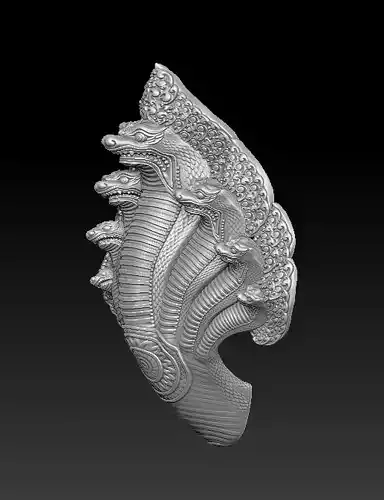1/12
Stories of nāgas (Khmer: នាគ, néak) have been part of Khmer society for thousands of years, dating back to the Funan era (នគរភ្នំ). According to reports from two Chinese envoys, Kang Tai and Zhu Ying, the state of Funan was established in the 1st century CE when an Indian prince named Kaundinya I (កៅណ្ឌិន្យទី១) married a nāga princess named Soma (សោមាកូនព្រះចន្ទ saôma kon preah chan; Soma, daughter of the moon god; Chinese: 柳葉, 柳叶 Liuye; Willow Leaf). The couple is symbolized in the story of Preah Thong and Neang Neak. As the legend goes, Kaundinya received instruction in a dream to take a magic bow from a temple and defeat Soma, the nāga princess and daughter of the nāga king. During the ensuing battle, they fell in love and later married, establishing the royal lineage of the Funan dynasty. Kaundinya subsequently constructed the capital city of Vyadhapura, and the kingdom became known as Kambujadeśa or Cambodia (កម្ពុជា, Kampuchea).[43][44][45] The love story between Kaundinya and Soma is the foundation for many standard practices in modern-day Khmer culture, including wedding ceremonies and other rituals.[46][47] The Khmer people regard themselves as descendants of the nāgas and many still believe the nāga exist today, destined to one day return and restore prosperity to their people.[citation needed]NāgaLiteratureSee also: Shesha, Vasuki, and ManasaThe Mahabharata epic is the first text that introduces nāgas; it describes them in detail and narrates their stories.[21] The cosmic snake Shesha, the nagarajas (nāga kings) Vasuki, Takshaka, Airavata and Karkotaka, and the princess Ulupi, are all depicted in the Mahabharata.
The Brahma Purana describes the reign of Adishesha as the king of the serpents in Patala:[22]
During the night the light of the moon is not utilised for its coolness but only forThe devas and the asuras decided to get Amṛta (Ambrosia—the celestial honey of immortalily) by churning the sea of milk. The Devas went to bring Mandara-mountain, to be used as the churning rod. Their attempt was futile. The asuras made a trial with the same result. The Bhūtagaṇas (Guards) of Śiva also made a vain attempt. On the instruction of Viṣṇu, Garuḍa went and brought the mountain as easily as an eagle takes away a frog. Now Vāsuki should be brought. The Devas and Gandharvas failed in that attempt also. Garuḍa who was haughty of his strength and speed, went to the city of the nāgas (serpents) and requested Vāsuki to come to the sea of Milk. Vāsuki replied that if tManasā is the mind-born daughter of Maharṣi Kaśyapa; hence she is named Manasā; or it may be She who plays with the mind is Manasā. Or it may be She who meditates on God with her mind and gets rapture in Her meditation of God is named Manasā. She finds pleasure in Her Own Self, the great devotee of Viṣṇu, a Siddha Yoginī. For three Yugas She worshipped Śrī Kṛṣṇa and then She became a Siddha Yoginī. Śrī Kṛṣṇa, the Lord of the Gopīs, seeing the body of Manasā lean and thin due to austerities, or seeing her worn out like the Muni Jarat Kāru called her by the name of Jarat Kāru. Hence Her name has come also to be Jarat Kāru. Kṛṣṇa, the Ocean of Mercy, gave her out of kindness, Her desired boon; She worshipped Him and Śrī Kṛṣṇa also worshipped Her. Devī Manasā is known in the Heavens, in the abode of the Nāgas (serpents), in earth, in Brahmāloka, in all the worlds as of very fair colour, beautiful and charming. She is named Jagad Gaurī as she is of a very fair colour in the world. Her other name is Śaivī and she is the disciple of Śiva. She is named Vaiṣṇavī as she is greatly devoted to Viṣṇu. She saved the Nāgas in the Snake Sacrifice performed by Pariksit, she is named Nageśvarī and Nāga Bhaginī and She is capable to destroy the effects of poison. She is called Viṣahari. Cambodian seven-headed nāga at the Royal Palace in Phnom Penh.Stories of nāgas (Khmer: នាគ, néak) have been part of Khmer society for thousands of years, dating back to the Funan era (នគរភ្នំ). According to reports from two Chinese envoys, Kang Tai and Zhu Ying, the state of Funan was established in the 1st century CE when an Indian prince named Kaundinya I (កៅណ្ឌិន្យទី១) married a nāga princess named Soma (សោមាកូនព្រះចន្ទ saôma kon preah chan; Soma, daughter of the moon god; Chinese: 柳葉, 柳叶 Liuye; Willow Leaf). The couple is symbolized in the story of Preah Thong and Neang Neak. As the legend goes, Kaundinya received instruction in a dream to take a magic bow from a temple and defeat Soma, the nāga princess and daughter of the nāga king. During the ensuing battle, they fell in love and later married, establishing the royal lineage of the Funan dynasty. Kaundinya subsequently constructed the capital city of Vyadhapura, and the kingdom became known as Kambujadeśa or Cambodia (កម្ពុជា, Kampuchea).[43][44][45] The love story between Kaundinya and Soma is the foundation for many standard practices in modern-day Khmer culture, including wedding ceremonies and other rituals.[46][47] The Khmer people regard themselves as descendants of the nāgas and many still believe the nāga exist today, destined to one day return and restore prosperity to their people.[citation needed]
REVIEWS & COMMENTS
accuracy, and usability.












